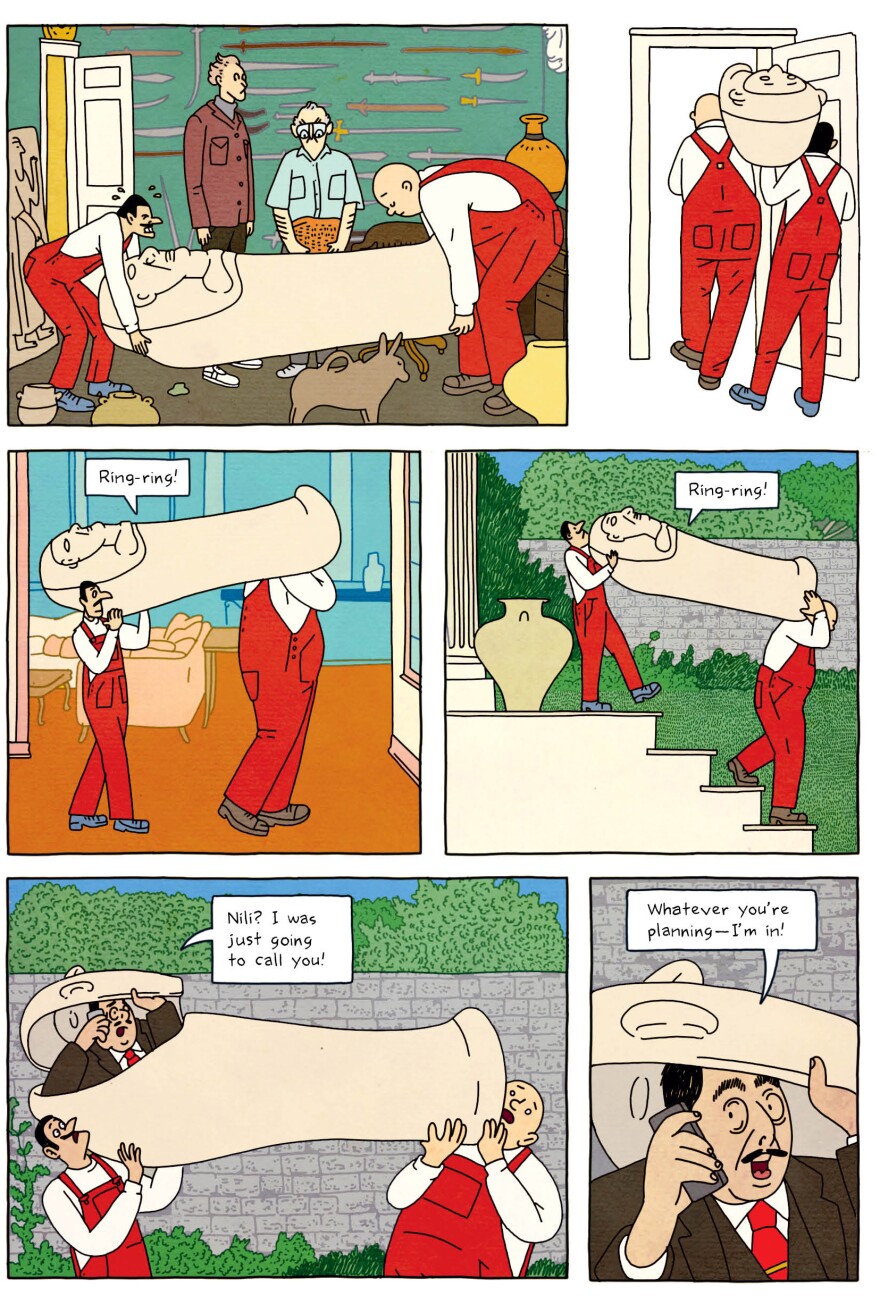If there's always a fine line between "hilarious" and "offensive," Israeli comics artist Rutu Modan is one heck of a tightrope walker.
This is a woman who managed to edit the Israeli edition of Mad magazine and then continue to have a career afterwards. The two graphic novels she's had published in the U.S. address Israeli and Jewish political issues with masterful balance and compassion. The fact that these balanced, compassionate narratives are told through equally balanced, elegant drawings suggests she may be some kind of multidisciplinary prodigy.
Tunnels is more acerbic than 2007's Exit Wounds and 2013's The Property (both of which won Eisner Awards). What's particularly engaging about Modan's latest turn is how she expresses it: Not in words, but through a change in style. The character designs in Tunnels are absurdly cartoony. Aside from some pointed exceptions, they consist of hasty-seeming — even awkward — clusters of fat lines. Their features jostle for space on their faces, and they almost always have one exaggerated marker like a pointy nose or thick eyebrows. When Modan's characters feel strong emotions, they show it Sunday-funnies style: Their hair might stand on end, or they'll stamp their feet and spew spittle.
Readers unfamiliar with Modan's previous work may not get the joke — not that it's really all that funny. Only cartoon characters, Modan suggests, can possibly reflect the cartoonish levels of greed and self-deceit revealed as her tale unspools. Bobbing clumsily in front of Modan's lacy backgrounds, the characters embody the contrast between human pettiness and the majestic forces of time and nature.
Modan's story focuses on the perennially controversial topic of archaeological exploration of the Holy Land. The book kicks off with Nili, the daughter of a brilliant archaeologist and his halfhearted successor, coming across an ancient tablet she's never seen before. It's been hidden from researchers in the private hoard of Mr. Abuloff, a wealthy collector who buys up crucial relics from ISIS but barely understands their significance. Nili realizes this particular tablet tells the location of that artifact among artifacts, the legendary Ark of the Covenant. She immediately decides she must excavate it, not so much to enjoy the fame that would accompany such a find — and certainly not out of religious commitment — but to complete her father's work. She went along on digs with him when she was a child, and even remembers getting close to the location indicated on the tablet. Since then, though, she's seen the credit for her father's achievements stolen by a greedy rival — the renowned, rapacious Rafi Sarid. Her father has succumbed to dementia.
Rafi discovers what Nili's after and sets out to find it himself. He has a halfhearted partner in Nili's brother Broshi, who hopes the great man can help him get tenure — and also resents his sister for sticking him with the burden of their father's care. Complicating matters, the old dig site that Nili remembers is now located on the other side of one of the arbitrary lines, drawn by the Oslo Accords in the 1990s, that divide the country into Israeli- and Palestinian-controlled zones. There's a terrific illustration of Nili and Abuloff arriving at the site on their map only to gaze up, dwarfed, at a massive border wall.

Soon an array of interested parties discover what Nili and Rafi are up to and lend help to one side or another. (Would-be excavators, take note! To judge from this book, it's practically impossible to dig anywhere in Israel without word leaking out immediately.) With the exception of Nili and Broshi, who are slightly more complex, all the characters broadly symbolize various impure motives: greed (Abuloff), glory (Rafi), zealotry (scripture-quoting activist Shmuel Gedanken, who's accompanied everywhere by a peanut gallery of dimwitted young Zionists), and the need to scrape a living (two Palestinians who hope to use the tunnels for smuggling.)
Tunnels' archaeological story isn't as layered as it could be. Nili in particular isn't a very well-developed protagonist; she's clearly supposed to be an everyperson, but she doesn't have much of an inner life. Actually, the book's most potent character is a red cow that Gedanken brings to the site to be sacrificed. To the humans it's nothing but a symbol, a creature whose color happens to mark it for death according to Chapter 19 of the Book of Numbers. But Modan turns it into a trickster figure and, by the end, arguably the most relatable being there.
Judging Tunnels on its story is beside the point, though. The complexities of Modan's themes are expressed through her art, not her words. The varied styles she employs create a discordant visual rhythm and a sense of constant challenge. Contemplating the shallowness and entitlement of Modan's characters, readers may wind up reflecting on their own.
Etelka Lehoczky has written about books for The Atlantic, The Los Angeles Review of Books and The New York Times. She tweets at @EtelkaL.
Copyright 2021 NPR. To see more, visit https://www.npr.org.





